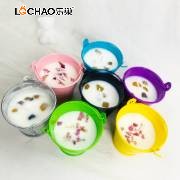The price of scented candles varies greatly, ranging from tens to thousands of yuan. This is primarily determined by the following core factors, which together constitute a candle's "value":
I. Core Raw Material Cost (This is the foundation)
1. Wax-Based Material
· Soybean/Coconut Wax: Currently the mainstream in the high-end market. Natural, environmentally friendly, clean burning, and with a low melting point, resulting in a long burn time and a softer fragrance.
Costs are higher than paraffin wax.
· Beeswax: One of the most natural waxes, but with limited production and a high price. It releases negative ions and purifies the air when burned, has an extremely long burn time, and has a natural honey
aroma.
· Paraffin: Extracted from petroleum, it is the lowest cost and is the preferred choice for most inexpensive candles. Its advantage is good shapeability, but combustion may produce black smoke and harmful
substances.
· Plant-Based Blends: Blends of soy wax with coconut wax, palm wax, and other waxes aim to combine the advantages of various waxes, with a cost somewhere in between.
2. Fragrance Quality and Concentration
· Essential Oils vs. Fragrances:
· Natural essential oils: Extracted from plants, they offer a natural, complex aroma and often possess aromatherapy benefits (such as aiding sleep and enhancing mental alertness). However, they are very
expensive, especially for rare essential oils like Damascus rose and sandalwood.
· Artificial fragrances: Chemically synthesized, they are low-cost and offer a single, yet intense, aroma. They are the primary choice for affordable candles.
· Fragrance Concentration: The fragrance concentration directly determines a candle's "aromatherapy" (scent diffusion). High-end candles often have fragrance concentrations of 10% or more, while standard
candles may only have around 5%. A higher concentration naturally increases the cost.
3. Candle Wicks
· High-quality wicks (such as eco-friendly wood chip wicks or pure cotton wicks) ensure a smooth and complete burn, avoiding tunneling (where the candle burns through the center, leaving a ring of wax
around the edges). Candles of different diameters require wicks of varying specifications, which requires both technical expertise and testing costs.
II. Design and Craftsmanship
1. Container and Design
· Container: A heavy glass, a uniquely designed ceramic jar, or a metal jar costs significantly more than an ordinary thin-walled glass or plastic cup.
· Shape and Color: Complex shapes, hand-dyed gradient colors, artistic hand-painted patterns, etc., all increase production difficulty and cost.
2. Production Process
· Handmade vs. Machine-Produced:
· Handmade candles are produced in small batches, requiring more time and effort. Each jar may be slightly different and unique. This includes both "handmade costs" and "creative value."
· Machine-produced candles offer high efficiency, high uniformity, and low unit costs.
· Craftsmanship Complexity: For example, layering different colored waxes, creating marble patterns, and embedding decorative elements like dried flowers all require more complex processes and skilled
craftsmen.
III. Brand and Intangible Assets
1. Brand Value
· The price of renowned designer brands, luxury brands, or long-established professional fragrance brands includes a brand premium. You are paying not only for the product itself, but also for the taste,
lifestyle, and brand story it represents.
2. Perfume and Creativity
· A unique, layered "high-end fragrance" (such as top, middle, and base notes) is meticulously blended by professional perfumers. This reflects significant research and development costs and the perfumer's
creative value. Cheap candles typically have a single, linear scent.
3. Packaging
· High-end brands often have very sophisticated packaging, from the outer box and ribbons to the thank-you cards; these details increase the overall cost and the perceived value of the experience.
IV. Other Factors
1. Place of Origin and Import Taxes
· Importing well-known brand candles from France, the United States, and other countries incurs tariffs and international logistics costs, which are reflected in the final price.
2. Certification and Standards
· Candles with organic, eco-friendly, or vegan/cruelty-free certifications have stricter raw material selection and production processes, resulting in higher costs.
In summary:
· Affordable candles costing tens of yuan: Typically use paraffin wax and artificial fragrances, mass-produced by machines, with simple containers and low brand premium.
· Mid-to-high-end candles costing hundreds of yuan: Mainly use soy wax/coconut wax + high-quality fragrances or some essential oils, emphasizing design and fragrance blending; many are handmade or from
niche design brands.
· Luxury candles costing over a thousand yuan: May use beeswax or top-grade blended waxes + high-concentration natural essential oils, with custom scents created by renowned perfumers, expensive ceramic
or metal containers, from luxury or designer brands, and exquisitely packaged.
Therefore, when choosing scented candles, you can focus on the wax base, fragrance source, and brand identity based on your budget and needs to find the one that best suits you.





